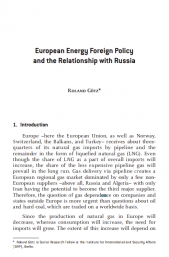
European Energy Foreign Policy and the Relationship with Russia

Introduction Excerpt
Europe –here the European Union, as well as Norway, Switzerland, the Balkans, and Turkey– receives about threequarters of its natural gas imports by pipeline and the remainder in the form of liquefied natural gas (LNG). Even though the share of LNG as a part of overall imports will increase, the share of the less expensive pipeline gas will prevail in the long run. Gas delivery via pipeline creates a European regional gas market dominated by only a few nonEuropean suppliers –above all, Russia and Algeria– with only Iran having the potential to become the third major supplier. Therefore, the question of gas dependence on companies and states outside Europe is more urgent than questions about oil and hard coal, which are traded on a worldwide basis.
Since the production of natural gas in Europe will decrease, whereas consumption will increase, the need for imports will grow. The extent of this increase will depend on diverse factors, including political decisions. This is why statementsabout future import dependency are only conditionally valid. The European Commission (EC, 2007: 3) writes in its main document on European energy policy: “Reliance on imports of gas is expected to increase from 57% to 84% by 2030.” This proposition is limited by two premises: First, it refers to the EU-27 (the EU without Norway), whereas the import dependency of Greater Europe would be less if Norway were counted as a European country. 1 Secondly, in this document a “business as usual” policy is assumed, whereas the EU is planning an increase in energy efficiency and greater use of renewable energies. If this policy succeeds, European import dependency would clearly increase less than the “standard prognoses” assume.
- Issues:
- Energy, Natural Resources
- Region:
- Europe
- Country:
- Russia
- Year Published:
- 2009
- Author:
- Roland Götz
- Institution:
- Institut Français des Relations Internationales (Ifri) / French Institute of International Relations

